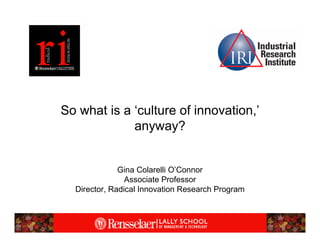Gina o connor_rpi
- 1. So what is a ‘culture of innovation,’ anyway? Gina Colarelli O’Connor Associate Professor Director, Radical Innovation Research Program
- 2. Radical Innovation Research Program, Phase II Corporate Capability Development for the Management of Radical Innovation • Objective: To understand how organizations can systematically develop, evolve and sustain their radical innovation competencies. – What firms are doing to develop and support radical innovation, as a distinctive activity, requiring distinctive management techniques: • Leadership and Culture • Organizational Structure and Interfaces Management • Governance and Decision Making • Specific Processes and Tools System • Skills Elements • Metrics • Mechanisms to enhance an organization’s RI capability. • Most effective implementation techniques for instituting those mechanisms. 2
- 3. Companies in the Study Phase I Phase II Cohort I Cohort II Cohort III 1995 to 2000 2001-2005 2004 to 2005 IBM Bose GE 246 interviews Dow Corning Air Products Guidant DuPont H-P Analog Devices 3M Intel Polaroid Albany Int’l P&G Nortel Networks Corning PPG Otis Elevator (UTC) Shell Chemicals Rohm&Haas TI Kodak Xerox GM Mead-Westvaco Sealed Air J&J Consumer 3
- 4. Agenda • Is a ‘culture of innovation’ enough? • Cultural differences that really matter. • Cultural differences that do not really matter. • A systems approach and cultural challenges. 4
- 5. Is a Culture of Innovation Enough? Organizational Approach Clear Strategic Mandate Culture of Innovation Local Approach Whole Systems Approach # of Whole Systems Mandate Firms Local Culture Mandate 5 Radicalness R
- 6. Cultural Differences that Matter • Orientation to Talent – Only some people can be successful in innovation space vs. most everyone can be and should be multi- dextrous. • Network Richness (vs. Network sterility) – Many contacts and ability to tap expertise of internal and external networks. • Resource Fluidity (vs. Rigidity) – Flexibility to borrow and trade the right people. • Organizational Fluidity (vs. Rigidity) – Ability to create new structures to accommodate new businesses that do not fit. 6
- 7. Cultural Differences that Do Not Matter RI System Capabilities Emphasis: 4 Approaches Competency & Competency & Strategy Driven Strategy Driven Readiness Readiness Model Model Model Model Execution Execution Rational Rational Driven Driven Build Technical Model Model Define New Model Model Competencies Technology and Sense Growth Areas Market and Commit Opportunities Identify and Integrate Aligned with Current Resources Growth Platforms in Businesses and Other to New Businesses Structure for Unaligned 7
- 8. DIA Systems Approach Oversee Transitions/Interfaces Discovery Incubation Acceleration Evolving the Ramping Creation, opportunity into up the recognition, business to elaboration, a business stand on its articulation proposition own of opportunities. Exploration Experimentation Exploitation •Basic Research •Technical •Focus •Internal Hunting •Market Learning •Respond •External Hunting •Market Creation •Invest /License/Purchase •Strategic domains /Invest 8
- 9. Culture and Leadership Challenges • In every case, Discovery is ‘owned,’ at senior leadership level… – But in most cases, I and A are not, so resource and organization issues get in the way of success. • More important to remove disincentives than to give incentives. – Individuals can get burned in this system. • Incubation is about experimentation and generation of options. – Metrics frequently drive for targeting and financial results. 9
- 10. Culture and Leadership Challenges • Early market participation and early harvesting may violate company culture. • Aligned opportunities are strategically more comfortable, but tactically more difficult. – GE CEO program the exception. – Bully pulpit???? • Governance/decision making boards sometimes double as coaches…. – Conflict of interest. – Different type of talent needed. – Time management troubles. 10
- 11. Sustaining an Innovation Culture Mandate/Scope Metrics Leadership & Governance Structures Portfolio Management Skills/Talent System Resources Development Reward/Punishment Processes Systems 11 Evolution Elements
